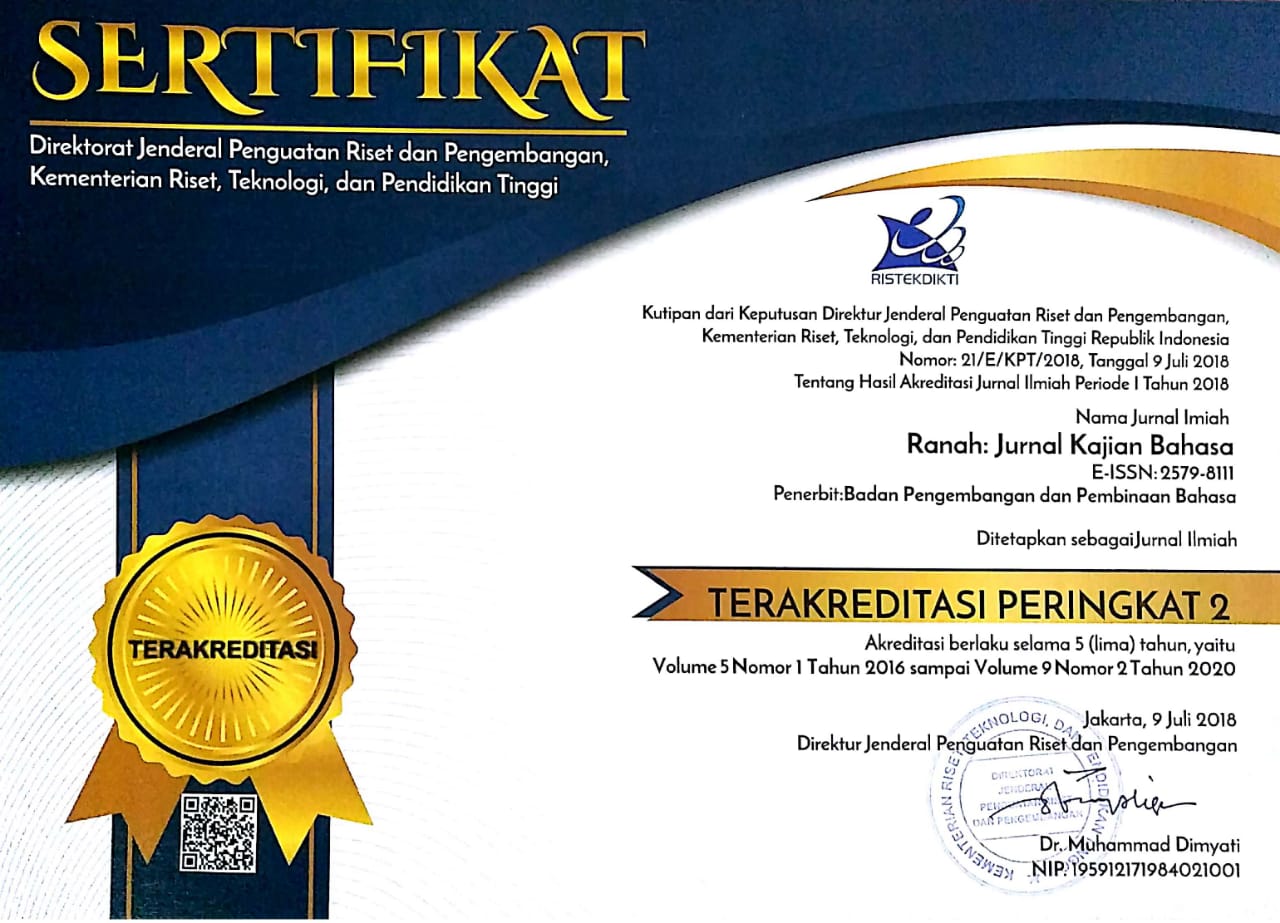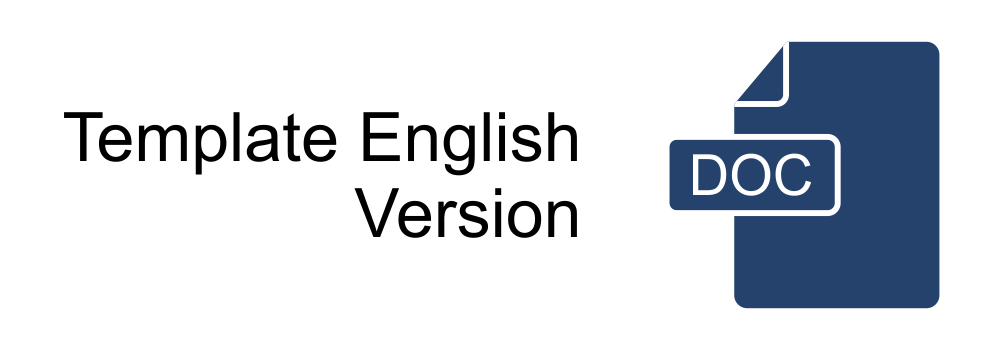Skinny, Slim, dan Thin: Analisis Berbasis Korpus Kata Sifat Identik dan Implikasinya pada Pengajaran Bahasa Inggris
Abstract
This paper is an exploratory corpus-based investigation into a group of near synonymous adjectives: skinny, slim, and thin. It employs the British National Corpus (BNC) as data and Sketch Engine as data analysis instrument. By using corpus linguistics techniques such as concordance and collocation analysis, it compares the synonymous words’ usage, meaning, and pattern to identify which synonymous words are more appropriate in a certain context. The results suggest that thin has neutral nuance expression and slim tends to carry positive connotation, while skinny is often used by speakers when they want to be more pejorative or deprecating. Moreover, unlike skinny which mainly modifies animate-related nouns, slim is more heterogeneous as they also can modify inanimate-related nouns and when it collocates with inanimate nouns, it often extends its’ meaning into metaphor expression which means ‘small’. Thin is used in many idiomatic expressions and when combined with common words it can also be used to denote metaphorical meaning. These findings can be applied in English language teaching so that students will be able to use the synonymous adjectives in an apt context and to avoid undesirable implication.
ABSTRAK
Penelitian ini adalah analisis berbasis korpus pada kelompok kata sifat yang hampir sama: “skinny”, “slim”, dan “thin”. Penelitian ini menggunakan British National Corpus (BNC) sebagai data dan Sketch Engine sebagai instrumen analisis data. Dengan menggunakan teknik linguistik korpus seperti konkordansi dan analisis kolokasi, artikel ini membandingkan penggunaan, makna, dan pola kata sinonim untuk mengidentifikasi kata-kata sinonim yang lebih tepat dalam konteks tertentu. Hasilnya menunjukkan bahwa “thin” memiliki ekspresi nuansa netral dan “slim” cenderung membawa konotasi positif, sementara “skinny” sering digunakan oleh pembicara ketika mereka ingin lebih merendahkan atau mencela. Selain itu, tidak seperti “skinny” yang banyak memodifikasi nomina yang berhubungan dengan benda hidup, “slim” lebih heterogen karena mereka juga dapat memodifikasi nomina yang tidak hidup dan ketika ia bertaut dengan kata benda tak hidup, ia sering memperluas maknanya menjadi ekspresi metafora yang berarti “small”/kecil. “Thin” digunakan dalam banyak ekspresi idiomatis dan ketika dikombinasikan dengan kata-kata umum, “thin” juga dapat digunakan untuk menunjukkan makna metaforis. Temuan ini dapat diterapkan dalam pengajaran bahasa Inggris sehingga siswa akan dapat menggunakan kata sifat sinonim dalam konteks yang tepat dan untuk menghindari implikasi yang tidak diinginkan.
Keywords
Full Text:
PDFReferences
REFERENCES
Aston, G., & Burnard, L. (1998). The BNC Handbook: Exploring the British National Corpus with SARA. Edinburgh: Edinburgh University Press.
Baker, P. (2006). Using Corpora in Discourse Analysis. London: Continuum.
Baker, P., Hardie, A., & McEnery, T. (2006). A Glossary of Corpus Linguistics. Edinburgh: Edinburgh University Press.
Bernardini, S. (2015). Translation. In D. Biber & R. Reppen (Eds.), The Cambridge Handbook of English Corpus Linguistics (pp. 515-536). Cambridge: Cambridge University Press.
Breyer, Y. (2009). Learning and teaching with corpora: Reflections by student teachers. Computer Assisted Language Learning, 22(2), 153-172. doi:10.1080/09588220902778328
Chambers, A. (2010). What is data driven? In A. O'Keeffe & M. McCarthy (Eds.), The Routledge Handbook of Corpus Linguistics (pp. 345-359). London: Routledge.
Cheng, W. (2010). What can corpus tell us about teaching? In A. O'Keeffe & M. McCarthy (Eds.), The Routledge Handbook of Corpus Linguistics (pp. 319-332). London: Routledge.
Collins Cobuild Advanced Leaner’s English Dictionary (2006) (5th ed.). Glasgow: HarperCollins.
Conrad, S. (2000). Will Corpus Linguistics Revolutionize Grammar Teaching in the 21st Century? Tesol Quarterly, 34(3), 548-560.
Divjak, D., & Gries, S. T. (2006). Ways of trying in Russian: clustering behavioral profiles. Corpus Linguistics and Linguistic Theory, 2(1), 23-60. doi:10.1515/CLLT.2006.002
Edmonds, P., & Hirst, G. (2002). Near-Synonymy and Lexical Choice. Computational Linguistics, 28(2), 105-144. doi:10.1162/089120102760173625
Fajri, M. S. A. (2017). Hegemonic and minority discourses around immigrants: A corpus-based critical discourse analysis. Indonesian Journal of Applied Linguistics, 7(2), 381-390. doi:10.17509/ijal.v7i2.8349
Flowerdew, L. (2009). Applying corpus linguistics to pedagogy. International Journal of Corpus Linguistics, 14(3), 393-417. doi:10.1075/ijcl.14.3.05flo
Gavioli, L., & Aston, G. (2001). Enriching reality: language corpora in language pedagogy. ELT journal, 55(3), 238-246. doi:10.1093/elt/55.3.238
Gilquin, G., & Gringer, S. (2010). How can data-driven learning be used in language teaching? . In A. O'Keeffe & M. McCarthy (Eds.), The Routledge Handbook of Corpus Linguistics (pp. 359-371). London: Routledge.
Gries, S. (2001). A corpus linguistic analysis of English -ic vs -ical adjectives. ICAME Journal, 25, 65-108.
Gries, S., & Otani, N. (2010). Behavioral profiles: a corpus-based perspective on synonymy and antonymy. ICAME Journal, 34, 121-150.
Hanks, P. (2012). The corpus revolution in lexicography. International Journal of Lexicography, 25(4), 398-436. doi:10.1093/ijl/ecs026
Hunston, S. (2002). Corpora in Applied Linguistics. Cambridge: Cambridge University Press.
Liu, D. (2010). Is it a chief, main, major, primary, or principal concern? A corpus-based behavioral profile study of the near-synonyms. International Journal of Corpus Linguistics, 15(1), 56-87. doi:10.1075/ijcl.15.1.03liu
Liu, D., & Espino, M. (2012). Actually, Genuinely, Really, and Truly: A corpus-based Behavioral Profile study of near-synonymous adverbs. International Journal of Corpus Linguistics, 17(2), 198-228. doi:10.1075/ijcl.17.2.03liu
McCarthy, M., & O'Keeffe, A. (2010). Historical perspective: what are corpora and how have they evolved? In A. O'Keeffe & M. McCarthy (Eds.), The Routledge Handbook of Corpus Linguistics (pp. 3-13). London: Routledge.
McCarthy, M., O'Keeffe, A., & Walsh, S. (2010). Vocabulary Matrix: Understanding, Learning, Teaching. Boston: Cengage Learning.
McEnery, T., & Wilson, A. (2004). Corpus Linguistics: An Introduction (2nd ed.). Edinburgh: Edinburgh University Press.
McEnery, T., & Xiao, R. (2011). What corpora can offer in Language Teaching and Learning? In L. Hinkel (Ed.), Handbook of Research in Second Language Teaching and Learning (Vol. 2, pp. 364-380). London: Routledge.
Meyer, C. F. (2002). English Corpus linguistics: An Introduction. Cambridge: Cambridge University Press.
O'keeffe, A., McCarthy, M., & Carter, R. (2007). From Corpus to Classroom: Language Use and Language Teaching. Cambridge: Cambridge University Press.
Sinclair, J. M. (2004). How to Use Corpora in Language Teaching (Vol. 12). Amsterdam: John Benjamins Publishing.
Taylor, J. R. (2003). Near synonyms as co-extensive categories: ‘high’ and ‘tall’ revisited. Language Sciences, 25(3), 263-284. doi:10.1016/S0388-0001(02)00018-9
Timmis, I. (2015). Corpus Linguistics for ELT. New York: Routledge.
Walker, C. (2011). How a corpus-based study of the factors which influence collocation can help in the teaching of business English. English for Specific Purposes, 30(2), 101-112. doi:10.5054/tq.2011.247710
Widdowson, H. G. (1998). Context, community, and authentic language. Tesol Quarterly, 32(4), 705-716.
DOI: https://doi.org/10.26499/rnh.v8i1.894
Refbacks
- There are currently no refbacks.








